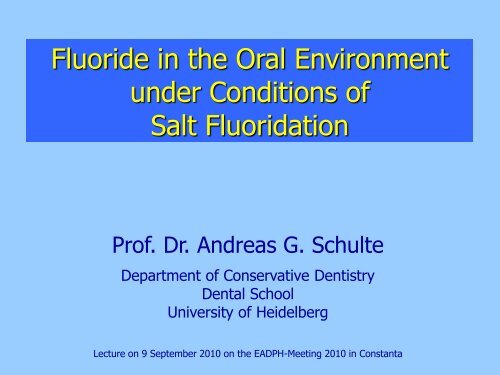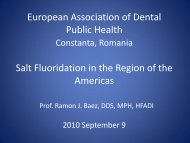Fluoride in the Oral Environment under Conditions of Salt Fluoridation
Fluoride in the Oral Environment under Conditions of Salt Fluoridation
Fluoride in the Oral Environment under Conditions of Salt Fluoridation
You also want an ePaper? Increase the reach of your titles
YUMPU automatically turns print PDFs into web optimized ePapers that Google loves.
<strong>Fluoride</strong> <strong>in</strong> <strong>the</strong> <strong>Oral</strong> <strong>Environment</strong><br />
<strong>under</strong> <strong>Conditions</strong> <strong>of</strong><br />
<strong>Salt</strong> <strong>Fluoridation</strong><br />
Pr<strong>of</strong>. Dr. Andreas G. Schulte<br />
Department <strong>of</strong> Conservative Dentistry<br />
Dental School<br />
University <strong>of</strong> Heidelberg<br />
Lecture on 9 September 2010 on <strong>the</strong> EADPH-Meet<strong>in</strong>g 2010 <strong>in</strong> Constanta
Schulte A, Rossbach R, Tram<strong>in</strong>i P:<br />
Association between caries experience<br />
<strong>of</strong> 12-year-old children from Heidelberg,<br />
Germany, and Montpellier, France,<br />
and different preventive measures<br />
Community Dentistry and <strong>Oral</strong> Epidemiology<br />
2001;; 29: 354-361
Association betwen Caries Experience<br />
and Preventive Measures <strong>in</strong> 12-year-olds<br />
(Data from Heidelberg 1998)<br />
Use <strong>of</strong> F-<strong>Salt</strong><br />
Use <strong>of</strong> F-Gel<br />
mean<br />
DMFT<br />
with<br />
mean<br />
DMFT<br />
without<br />
p-value<br />
1.32 1.71 0.01<br />
1.37 1.71 0.03<br />
Use <strong>of</strong> F-<strong>Salt</strong> and F-Gel 1.01 1.82 0.03<br />
Fissure Sealants 1.21 2.15 0.0001<br />
Study Schulte et al. 2001
Association between Caries Experience<br />
and 2 Preventive Measures <strong>in</strong> Germany<br />
(12-year-old children;; National Data)<br />
Mean<br />
DMFT<br />
Share<br />
Fluoridated<br />
<strong>Salt</strong>*<br />
Proportion<br />
Fissure<br />
Sealants<br />
1994 2.44 5% 6%<br />
1997<br />
1.81 19% 29%<br />
2000 1.24 41% 62%<br />
2004 0.98 61% 66%<br />
From: Pieper K and Schulte AG, CDH (2004); Schulte AG et al., CDH (2006)
Pieper K, Born C, Hartmann T, He<strong>in</strong>zel-<br />
Gutenbrunner M, Jablonski-Mome<strong>in</strong>i A:<br />
Association <strong>of</strong> preventive measures<br />
with caries experience<br />
expressed by outcome variables.<br />
Schweizer Monatsschrift für Zahnmediz<strong>in</strong><br />
2007;; 117: 1038-1044
Caries Experience <strong>in</strong> 12-year-old Children<br />
from Marburg Region, Germany<br />
Mean<br />
D 3 MFT<br />
Mean<br />
D 3 MFS<br />
Mean<br />
D 1-2 S<br />
With use <strong>of</strong> F-<strong>Salt</strong> 0.63 0.89 1.45<br />
Without use <strong>of</strong> F-<strong>Salt</strong> 0.92 1.20 2.03<br />
Difference significant yes yes yes<br />
From: Pieper et al. 2007; Schweiz Monatsschr Zahnmed
Use <strong>of</strong> F-<strong>Salt</strong> and Mean DMFT <strong>in</strong> German<br />
Adults with Mental Disabilities <strong>in</strong> 2007<br />
with use <strong>of</strong><br />
F-<strong>Salt</strong><br />
no use <strong>of</strong><br />
F-<strong>Salt</strong><br />
p-Value<br />
n 184 102<br />
Mean age 33.8 35.1 >0.05<br />
Mean DMFT 10.9 12.8
Market Shares <strong>of</strong> <strong>Salt</strong> with<br />
Iod<strong>in</strong>e and <strong>Fluoride</strong> <strong>in</strong> Germany
Fea<strong>the</strong>rstone JDB:<br />
Prevention and reversal <strong>of</strong> dental caries: role<br />
<strong>of</strong> low level fluoride.<br />
Community Dentistry and <strong>Oral</strong> Epidemiology<br />
1999;; 27: 31-40
Important Informations from <strong>the</strong><br />
Fea<strong>the</strong>rstone Paper<br />
1. At fluoride concentrations <strong>of</strong> 0.03 ppm <strong>in</strong> saliva<br />
rem<strong>in</strong>eralisation <strong>of</strong> enamel is enhanced.<br />
2. Salivary F-concentration <strong>of</strong> children liv<strong>in</strong>g <strong>in</strong> communities<br />
with water fluoridation is <strong>the</strong> same as that <strong>of</strong> children<br />
liv<strong>in</strong>g <strong>in</strong> areas without water fluoridation.<br />
3. In a follow-up study children with high <strong>in</strong>dividual salivary<br />
F-content (>0.075 ppm) were more frequently caries-free<br />
than children with lower salivary F-values.
<strong>Fluoride</strong> Concentration <strong>in</strong> Saliva <strong>of</strong> Adults<br />
after Use <strong>of</strong> F-toothpaste<br />
2.5<br />
mg/l<br />
2.0<br />
1.5<br />
1.0<br />
0.5<br />
0<br />
-5 5 10 20 30 60 90 120 M<strong>in</strong>utes<br />
From: Bernhart G and Schulte AG 2000; J Dent Res (Abstract)
Machiulskiene V, Richards A, Nyvad B:<br />
Salivary <strong>Fluoride</strong> Concentrations <strong>in</strong><br />
Preschool Children after Use <strong>of</strong><br />
Fluoridated <strong>Salt</strong> or <strong>Fluoride</strong> Toothpaste<br />
Caries Research 2004;; 38: 379<br />
Abstract # 66
Design and Results <strong>of</strong> <strong>the</strong> Study from<br />
Machiulskiene et al. 2004<br />
- 10 children aged 5 years were <strong>in</strong> <strong>the</strong> test group<br />
- In K<strong>in</strong>dergarten <strong>in</strong>take <strong>of</strong> a warm ma<strong>in</strong> meal<br />
hav<strong>in</strong>g been prepared with F-<strong>Salt</strong><br />
- Salivary samples taken prior to and after lunch<br />
F-concentration <strong>in</strong> saliva:<br />
0.03 mg/l prior to lunch<br />
0.11 mg/l after lunch<br />
Difference was statistically significant!
Björnström H, Naji S, Simic I, Sjöström I,<br />
Twetman S:<br />
<strong>Fluoride</strong> Levels <strong>in</strong> Saliva and Dental Plaque<br />
after Consumption <strong>of</strong> Snacks prepared<br />
with Fluoridated <strong>Salt</strong><br />
European Journal <strong>of</strong> Pediatric Dentistry<br />
2004;; 5: 41-45
Design <strong>of</strong> <strong>the</strong> study from<br />
Björnström et al. 2004<br />
Participants: 11 adults<br />
Type <strong>of</strong> meal: 500 ml salted popcorn per<br />
participant<br />
Contacttime: complete <strong>in</strong>take with<strong>in</strong> 30 m<strong>in</strong>utes<br />
Collection <strong>of</strong> saliva: unstimulated whole saliva<br />
<strong>Fluoride</strong> measurment: <strong>in</strong> centrifugated salivary<br />
supernatent
Salivary <strong>Fluoride</strong> Concentration<br />
after Intake<br />
<strong>of</strong> Snacks prepared with F-<strong>Salt</strong><br />
mg/l<br />
0.40<br />
0.36<br />
0.32<br />
0.28<br />
0,24<br />
0.20<br />
0.16<br />
0.12<br />
0.08<br />
0.04<br />
0<br />
prior to<br />
meal<br />
*statistically significant<br />
*<br />
Test group<br />
*<br />
Control group<br />
30 60 120<br />
m<strong>in</strong>utes after <strong>in</strong>take <strong>of</strong> snacks<br />
*<br />
Study Björnström et al. 2004
Hedman J, Sjöman R, Sjöström I,<br />
Twetman S:<br />
<strong>Fluoride</strong> Concentration <strong>in</strong> Saliva<br />
after Consumption <strong>of</strong> a D<strong>in</strong>er prepared<br />
with Fluoridated <strong>Salt</strong><br />
Caries Research 2006;; 40: 158-162
Design <strong>of</strong> <strong>the</strong> study from<br />
Hedman et al. 2006<br />
Participant: 10 adolescents (11 to 16 years old)<br />
Test meal: Spaghetti with sauce and meat<br />
salted with F-<strong>Salt</strong><br />
Control meal: Spaghetti with sauce and meat<br />
salted with F-free <strong>Salt</strong><br />
Eat<strong>in</strong>g procedure: <strong>in</strong>take <strong>of</strong> 350-g-portion<br />
toge<strong>the</strong>r with one dr<strong>in</strong>k (250 ml fat reduced milk)<br />
Collection <strong>of</strong> saliva: stimulated whole saliva<br />
<strong>Fluoride</strong> measurement: <strong>in</strong> centrifugated salivary<br />
supernatant
Mean salivary <strong>Fluoride</strong> Concentration after<br />
Intake <strong>of</strong> a D<strong>in</strong>er prepared with F-<strong>Salt</strong><br />
mg/l<br />
0.20<br />
0.18<br />
0.16<br />
0.14<br />
0.12<br />
0.10<br />
0.08<br />
0.06<br />
0.04<br />
0.02<br />
0<br />
Prior to<br />
meal<br />
test group control group<br />
*<br />
*<br />
*<br />
5 10 30 180<br />
m<strong>in</strong>utes after <strong>in</strong>take <strong>of</strong> d<strong>in</strong>er<br />
*statististically significant<br />
Study Hedman et al. 2006
Kaiser D, Neumeister V, Stößer L,<br />
Hetzer G:<br />
<strong>Fluoride</strong> Concentration<br />
<strong>in</strong> Saliva and Plaque<br />
after Intake <strong>of</strong> Food prepared with F-<strong>Salt</strong><br />
(<strong>in</strong> German with English abstract)<br />
<strong>Oral</strong>prophylaxe und K<strong>in</strong>derzahnheilkunde<br />
2006;; 26: 110-114
Design <strong>of</strong> <strong>the</strong> Study from<br />
Kaiser et al. 2006<br />
Participants: 15 adults<br />
Type <strong>of</strong> meals: spaghetti;; rice;; mashed potatoes;;<br />
fluoridated water<br />
Contact time: 2 m<strong>in</strong>utes each<br />
Collection <strong>of</strong> saliva: unstimulated whole saliva<br />
<strong>Fluoride</strong> measurement: <strong>in</strong> whole saliva
Mean <strong>Fluoride</strong> Concentration <strong>in</strong> Saliva<br />
after Intake <strong>of</strong><br />
Foods prepared with F-<strong>Salt</strong><br />
mg/l<br />
0.20<br />
0.18<br />
0.16<br />
0.14<br />
0.12<br />
0.10<br />
0.08<br />
0.06<br />
0.04<br />
0.02<br />
0<br />
spaghetti rice mashed potatoes water<br />
Prior to<br />
<strong>in</strong>take <strong>of</strong> food<br />
*statistically significant<br />
*<br />
*<br />
*<br />
* * *<br />
5 30 60<br />
m<strong>in</strong>utes after <strong>in</strong>take <strong>of</strong> food<br />
*<br />
*<br />
Study Kaiser et al. 2006
Schulte AG, Gräber R, Kasperk C,<br />
Koch MJ, Staehle HJ<br />
Influence <strong>of</strong> Fluoridated <strong>Salt</strong> on<br />
Ur<strong>in</strong>ary Excretion <strong>of</strong> Adults<br />
Caries Research2002;; 36: 391-397
Design <strong>of</strong> <strong>the</strong> Study from<br />
Schulte et al. 2002<br />
Participants: 260 adults between 18 and 60 years old<br />
Test group: 200 persons tak<strong>in</strong>g ma<strong>in</strong> meal <strong>in</strong> cafeteria A<br />
where F-<strong>Salt</strong> is used<br />
Control group: 60 persons tak<strong>in</strong>g ma<strong>in</strong> meal <strong>in</strong> cafeteria B<br />
where no F-salt is used<br />
Collection times: Before <strong>in</strong>troduction <strong>of</strong> F-<strong>Salt</strong> <strong>in</strong> cafeteria A<br />
as well as 3, 6, 9, 12, 24 and 36 months after <strong>in</strong>troduction <strong>of</strong><br />
F-<strong>Salt</strong> <strong>in</strong> cafeteria A<br />
Collection <strong>of</strong> ur<strong>in</strong>e: for 24 h <strong>in</strong> 3 fractions<br />
<strong>Fluoride</strong> measurement: <strong>in</strong> ur<strong>in</strong>e samples
F-<strong>Salt</strong> <strong>in</strong> <strong>the</strong> Canteen <strong>of</strong> Heidelberg<br />
Medical and Dental School<br />
Foto: Kirsten Stoik, Heidelberg
Mean <strong>Fluoride</strong> Excretion<br />
<strong>in</strong> 24h-Ur<strong>in</strong>e<br />
µg/d<br />
1000<br />
800<br />
600<br />
400<br />
200<br />
Test group<br />
Control group<br />
0<br />
basel<strong>in</strong>e 3 6 9 12 24 36<br />
Monate<br />
No statistically significant difference with<strong>in</strong> both groups (p>0,33)!
Mean <strong>Fluoride</strong> Excretion<br />
<strong>in</strong> Morn<strong>in</strong>g-Ur<strong>in</strong>e<br />
µg/h<br />
60<br />
50<br />
40<br />
30<br />
20<br />
10<br />
Test group<br />
Control group<br />
0<br />
basel<strong>in</strong>e 3 6 9 12 24 36<br />
months<br />
No statistical difference with<strong>in</strong> <strong>the</strong> 2 groups (p>0,45)!
Mean <strong>Fluoride</strong> Excretion<br />
<strong>in</strong> Afternoon-Ur<strong>in</strong>e<br />
µg/h<br />
60<br />
test group<br />
control group<br />
50<br />
40<br />
30<br />
33,932,6<br />
43,6 42,4<br />
28,8<br />
31,1<br />
47,8<br />
26,9<br />
41,5<br />
33,9<br />
39,7<br />
29,5<br />
46,7<br />
33,3<br />
20<br />
10<br />
0<br />
basel<strong>in</strong>e 3 6 9 12 24 36<br />
months<br />
Statistical difference only with<strong>in</strong> test group (p=0,002).
Mean <strong>Fluoride</strong> Excretion<br />
<strong>in</strong> Even<strong>in</strong>g- and Night-Ur<strong>in</strong>e<br />
µg/h<br />
60<br />
50<br />
40<br />
30<br />
20<br />
10<br />
test group<br />
control group<br />
0<br />
basel<strong>in</strong>e 3 6 9 12 24 36<br />
months<br />
No statistically significant difference with<strong>in</strong> <strong>the</strong> 2 groups (p>0,45)!
Conclusions<br />
Even <strong>under</strong> conditions where a lot <strong>of</strong> caries preventive<br />
measures are applied fluoridated salt contributes to a<br />
a dist<strong>in</strong>ct reduction <strong>of</strong> caries prevalence<br />
Intake <strong>of</strong> a meal prepared with F-salt leads to a<br />
significant <strong>in</strong>crease <strong>of</strong> salivary F-concentration for<br />
30 m<strong>in</strong>utes.<br />
Intake <strong>of</strong> snacks prepared with F-salt leads to a<br />
significant <strong>in</strong>crease <strong>of</strong> salivary F-concentration for at<br />
least 60 m<strong>in</strong>utes<br />
F-salt has ma<strong>in</strong>ly a topical effect <strong>in</strong> <strong>the</strong> oral cavity by<br />
enhanc<strong>in</strong>g rem<strong>in</strong>eralisation.<br />
F-salt should not only be available for households but<br />
should also be used <strong>in</strong> cafeterias, canteens and<br />
restaurants.
Thank you Very much for Your attention!



